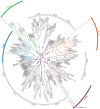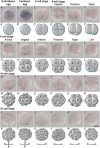Massive Gene Loss and Function Shuffling in Appendicularians Stretch the Boundaries of Chordate Wnt Family Evolution
- PMID: 34179025
- PMCID: PMC8220140
- DOI: 10.3389/fcell.2021.700827
Massive Gene Loss and Function Shuffling in Appendicularians Stretch the Boundaries of Chordate Wnt Family Evolution
Abstract
Gene loss is a pervasive source of genetic variation that influences species evolvability, biodiversity and the innovation of evolutionary adaptations. To better understand the evolutionary patterns and impact of gene loss, here we investigate as a case study the evolution of the wingless (Wnt) family in the appendicularian tunicate Oikopleura dioica, an emergent EvoDevo model characterized by its proneness to lose genes among chordates. Genome survey and phylogenetic analyses reveal that only four of the thirteen Wnt subfamilies have survived in O. dioica-Wnt5, Wnt10, Wnt11, and Wnt16,-representing the minimal Wnt repertoire described in chordates. While the loss of Wnt4 and Wnt8 likely occurred in the last common ancestor of tunicates, representing therefore a synapomorphy of this subphylum, the rest of losses occurred during the evolution of appendicularians. This work provides the first complete Wnt developmental expression atlas in a tunicate and the first insights into the evolution of Wnt developmental functions in appendicularians. Our work highlights three main evolutionary patterns of gene loss: (1) conservation of ancestral Wnt expression domains not affected by gene losses; (2) function shuffling among Wnt paralogs accompanied by gene losses; and (3) extinction of Wnt expression in certain embryonic directly correlated with gene losses. Overall our work reveals that in contrast to "conservative" pattern of evolution of cephalochordates and vertebrates, O. dioica shows an even more radical "liberal" evolutionary pattern than that described ascidian tunicates, stretching the boundaries of the malleability of Wnt family evolution in chordates.
Keywords: appendicularian tunicate chordate; chordate evolutionary developmental biology; gene function shuffling; gene loss; wingless (Wnt) family evolution.
Copyright © 2021 Martí-Solans, Godoy-Marín, Diaz-Gracia, Onuma, Nishida, Albalat and Cañestro.
Conflict of interest statement
The authors declare that the research was conducted in the absence of any commercial or financial relationships that could be construed as a potential conflict of interest.
Figures





Similar articles
-
Less, but More: New Insights From Appendicularians on Chordate Fgf Evolution and the Divergence of Tunicate Lifestyles.Mol Biol Evol. 2025 Jan 6;42(1):msae260. doi: 10.1093/molbev/msae260. Mol Biol Evol. 2025. PMID: 39686543 Free PMC article.
-
Developmental atlas of appendicularian Oikopleura dioica actins provides new insights into the evolution of the notochord and the cardio-paraxial muscle in chordates.Dev Biol. 2019 Apr 15;448(2):260-270. doi: 10.1016/j.ydbio.2018.09.003. Epub 2018 Sep 11. Dev Biol. 2019. PMID: 30217598
-
Wnt evolution and function shuffling in liberal and conservative chordate genomes.Genome Biol. 2018 Jul 25;19(1):98. doi: 10.1186/s13059-018-1468-3. Genome Biol. 2018. PMID: 30045756 Free PMC article.
-
Oikopleura dioica: An Emergent Chordate Model to Study the Impact of Gene Loss on the Evolution of the Mechanisms of Development.Results Probl Cell Differ. 2019;68:63-105. doi: 10.1007/978-3-030-23459-1_4. Results Probl Cell Differ. 2019. PMID: 31598853 Review.
-
Development of the appendicularian Oikopleura dioica: culture, genome, and cell lineages.Dev Growth Differ. 2008 Jun;50 Suppl 1:S239-56. doi: 10.1111/j.1440-169X.2008.01035.x. Dev Growth Differ. 2008. PMID: 18494706 Review.
Cited by
-
Integrated analysis of Wnt signalling system component gene expression.Development. 2022 Aug 15;149(16):dev200312. doi: 10.1242/dev.200312. Epub 2022 Aug 15. Development. 2022. PMID: 35831952 Free PMC article.
-
Unique trajectory of gene family evolution from genomic analysis of nearly all known species in an ancient yeast lineage.Mol Syst Biol. 2025 Aug;21(8):1066-1089. doi: 10.1038/s44320-025-00118-0. Epub 2025 May 27. Mol Syst Biol. 2025. PMID: 40425814 Free PMC article.
-
Less, but More: New Insights From Appendicularians on Chordate Fgf Evolution and the Divergence of Tunicate Lifestyles.Mol Biol Evol. 2025 Jan 6;42(1):msae260. doi: 10.1093/molbev/msae260. Mol Biol Evol. 2025. PMID: 39686543 Free PMC article.
-
A chelicerate Wnt gene expression atlas: novel insights into the complexity of arthropod Wnt-patterning.Evodevo. 2021 Nov 9;12(1):12. doi: 10.1186/s13227-021-00182-1. Evodevo. 2021. PMID: 34753512 Free PMC article.
-
Genome-wide identification and expression profiling of the Wnt gene family in three abalone species.Genes Genomics. 2024 Dec;46(12):1363-1374. doi: 10.1007/s13258-024-01579-7. Epub 2024 Oct 14. Genes Genomics. 2024. PMID: 39397130 Review.
References
LinkOut - more resources
Full Text Sources

